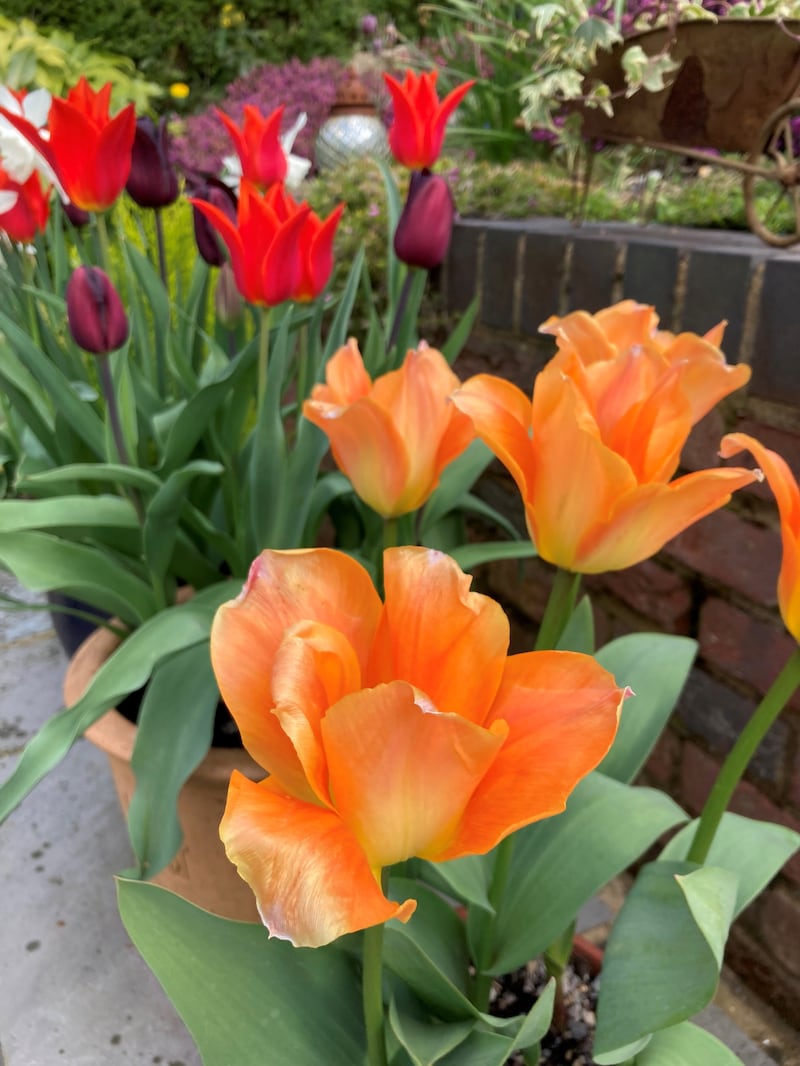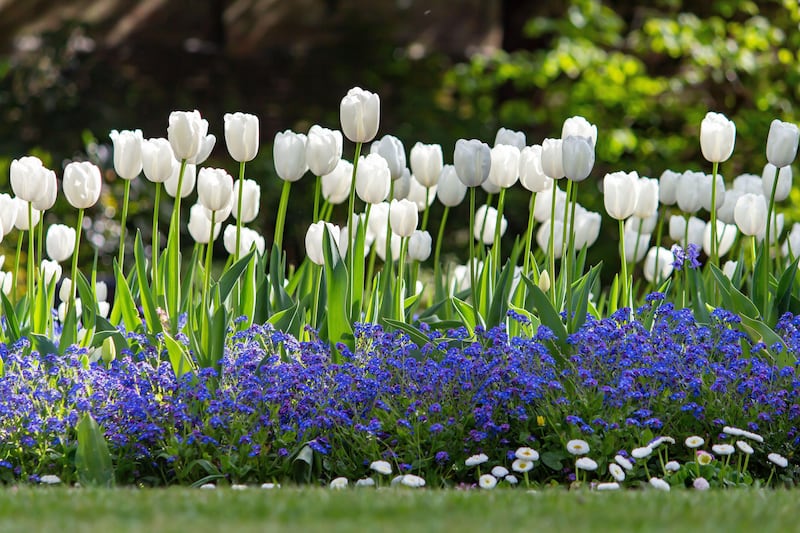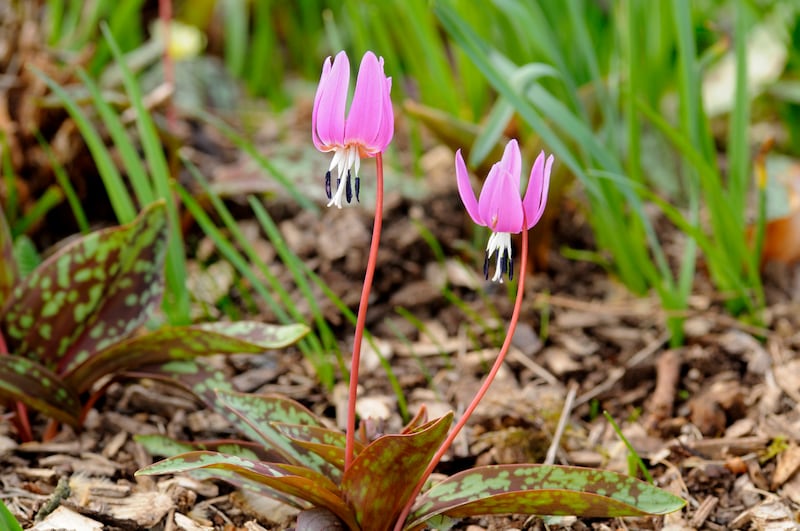When it comes to spring-flowering bulbs, there are a handful of go-to species that inevitably hog the limelight. Tulips, for instance, with their sleek, Hollywood starlet good looks. Daffodils, too, especially the newer varieties with their ruffled trumpets and elaborately layered petals that look like miniature salsa dresses. Alliums, also, with their sculptural drumsticks in shades of pink, purple and white that have an ability to look good in pretty much any style of garden. And of course, snowdrops, whose dainty beauty has captivated generations of gardeners.
But what about the many other garden-worthy kinds of spring-flowering bulbs that don’t get so much of a look-in? As the bulb planting season kicks off in earnest, I’m determined this year to include a generous selection of the latter.
Consider erythroniums, for example, a very graceful, hardy perennial woodlander generally only seen growing in the gardens of those in the know. They are happy in a humus-rich, damp but free-draining soil in dappled shade – in other words, the kind of growing conditions naturally found in established deciduous woodland – its slender-stemmed flowers are exquisite in every detail from their reflexed petals to their gentle shades of pale yellow, creamy-white, purple and pink. Those flowers emerge from dense, low clumps of glossy, often handsomely mottled leaves, dying back down to the ground as summer arrives.


Given the right spot, this bulbous perennial will happily naturalise over time, forming a generous carpet of colour in spring. Once established, erythroniums are also exceptionally long-lived. I once stumbled across drifts of them blooming in a very old, overgrown walled garden where they were surrounded by rough grass, resilient relics of another age.
READ MORE
Recommended varieties include the vigorous, floriferous, pale yellow-flowered Erythronium ‘Pagoda’; Erythronium ‘White Beauty’ whose palest-lemon flowers with their strongly recurved petals are the stuff of a botanical artist’s dreams; and Erythronium ‘Rose Queen’ (dusty pink flowers and marvellously mottled leaves).
Erythroniums pair brilliantly with trilliums, another aristocratic, shade-loving, spring-flowering woodlander, albeit one that needs time and care to properly establish. Its flowers have a strange extraterrestrial beauty underscored by their symmetrical trinity of three petals and three sepals poised elegantly above three leaves.
It’s most emphatically not the kind of spring-flowering bulb (or rhizome to be botanically correct) to throw in a pot in the expectation that up it will gaily pop the following year. But give trilliums cool, dappled shade beneath the elevated canopy and shelter of deciduous trees and a moist, free-draining, humus-rich, ideally acid soil enriched with leaf-mould, and the plants will grow well, slowly forming established clumps over time. Other common names include wood lily, wake robin, birthroot, and toad-shade.

One of the best as well as the easiest to grow is the white trillium, Trillium grandiflorum. A beautiful pale pink form of this hardy perennial, known as Trillium grandiflorum f roseum, was first introduced into cultivation by the famous Daisy Hill Nursery in Newry many years ago. Although only available from a handful of specialist nurseries, it’s well worth tracking down.
Those areas of the garden or allotment that enjoy the seasonal shade cast by deciduous trees and shrubs for part of the year are also ideal for many other kinds of spring-flowering bulbous species. Just make sure to annually carpet the ground with a layer of organic mulch to help maintain fertility and moisture.
Other lesser-known, garden-worthy examples include the charming Leucojum aestivum, commonly known as snowflake, a very pretty, long-blooming, spring-flowering bulbous perennial with strong stems up to 50cm tall along which a series of up to eight dainty, bell-shaped, green -tipped white flowers are arranged, each dangling from its own slender pedicel like glass baubles on a tree. Unsurprisingly it also makes a marvellous cut flower, especially the variety known as Leucojum ‘Gravetye Giant’.
For sunnier areas, seek out the bulbs of species of scilla, ipheion and puschkinia, all daintily decorative with short spikes of blue, white or pink flowers and which will also slowly naturalise to form dense clumps if given a fertile, humus-rich, moist but free-draining soil.
Just as for the shade lovers mentioned above, avoid planting them into areas prone to winter wet which will incline them to rot in the cold wet ground over winter. For this reason, they also make a great choice for spring pots and alpine troughs as well as raised beds, gravel gardens and rock gardens. Recommended varieties include Scilla luciliae (Boiss.) Speta; Scilla ‘Pink Giant’ (confusingly, formerly known as Chionodoxa ‘Pink Giant); Ipheion ‘Wisley Blue’; and Puschkinia scilloides var libanotica.
Best of all for small-scale container-growing is Iris reticulata, a miniature species with scented flowers of such eye-catching beauty that they beg to be admired close-up. Recommended varieties include the lavender-blue Iris reticulata ‘Alida’; lemon-yellow Iris reticulata ‘Katherine’s Gold’; and the pale gold and dusty blue Iris reticulata ‘Katharine Hodgkin’. All need a fertile, very free-draining soil ideally lightened with horticultural grit.
Other species of spring-flowering bulbs look right at home as embellishments to a Robinsonian-style wildflower meadow. Varieties of narcissus aside, an outstanding example is the extraordinarily graceful snake’s head fritillary, Fritillaria mealagris. Its bell-shaped chequered flowers appear in April on stems so slender that it seems a miracle they remain upright. Its favoured habitat is damp, open, sunny meadowland where it will often naturalise over time to form large colonies.
Or if you like the idea of very different kind of spring-flowering bulb with something of the swagger of a 1970s punk band, seek out its relative, Fritillaria imperialis, commonly known as the crown imperial. Its tall stout stems reach a height of a metre or more and are topped with a brilliant crown of bright yellow or orange bells capped with a jaunty mohawk of leafy green bracts. Happy in full sun and a rich, moist but very free-draining, alkaline soil, in cold, damp gardens it’s best grown in a raised bed or large tub. A few years ago, I spotted it flowering en-masse in a large sunny flower-bed just off Dublin’s Grand Canal, a sight as strange and enchanting as suddenly stumbling across a flock of pink flamingos. Was it hogging the limelight? Most definitely.
This week in the garden
Summer bedding displays have come to an end in all but the mildest, most sheltered gardens so it’s time to empty the plants from pots and beds and add them to the compost heap unless they are species that can be overwintered in a frost-free glasshouse or shed. Replace them with some winter/spring bedding and a few well-chosen evergreens underplanted with bulbs for an enduring display. Pot up some herbs and bring them indoors into a cool, bright space where they’ll provide plenty of fresh pickings in the months to come. Suitable herbs include parsley, mint, oregano, thyme and dill.
Dates for your diary
Saturday 12th, Airfield Estate, Dundrum, Dublin 14: Autumn Gathering of Community Growers 2024, and the launch of the annual National Allotments and Community Gardens Week. This event will include talks by a range of garden experts, seed sharing, tours of the gardens, discussions with community growers and more. cgireland.org
Tuesday, October 15th-Saturday, October 26th, in a variety of locations around the country: The National Acorn Gathering, a community-based initiative run by The Nature Trust and supported by Coillte and Forest Partners, takes place, encouraging volunteers to collect acorns of native oaks which will be used to propagate new trees. naturetrust.ie
















